Welcome back, dear family, to Agama’s Message by Agama Shakti. Today, I am excited to bring you the topic of Jyotish and share my understanding of this profound science. This edition is Discourse Two of the Beyond Consciousness series. I have provided the link below if you haven't checked out the previous two articles. Please do read them!
Introduction to Jyotish
असतो मा साद गमय, तमसो मा ज्योतिर् गमय, मृत्योर मा अमृतम् गमय
(Asato Ma Sad Gamaya, Tamaso Ma Jyotir Gamaya, Mrityor Ma Amritam Gamaya)
Lead us from ignorance to truth, Lead us from darkness to light, Lead us from death to deathlessness.
I'm providing you with an excerpt from the book I wrote for myself and my future generation on Jyotish. It is not available for sale, at least for now. This excerpt explains what Jyotish is and how an astrologer should be.
Shri Ganeshai Namaha
I welcome you to the section of knowledge, this is the part where I expect you to have a student mentality and memorize the pre-requisite.
Before starting to read this part make sure your pray to Dev Guru Shri Brihaspati, to bless you with the knowledge of astrology because astrology is a subject that is very close to your Atma (Soul), the word Jyotish originates by combining two syllables, Jyoti i.e the light (resembling soul) and Ish i.e Ishwar; Jyotish is a light guiding us towards the Ishwar (Supreme lord).
It is essential for an astrologer to follow a set of rules in order to benefit from this divine knowledge.
Gratitude - Be grateful to the planets for allowing you to take a glimpse into the future. We are just the medium never the source.
Intent - While making a prediction, the intention behind the prediction or analysis is very important, or the predictions may go wrong.
Satvikta - Both Shrimad Bhagwad Gita & Brihad Parashara Hora Shashtra talks about 3 gunas; Rajas, Tamas & Satva, I remember a video of Shri Srila Prabhupada in his last physical days talking about the reason for human birth… his message was, it is our responsibility to rise above rajas/tamas and move towards satva. Being an astrology student it is our responsibility to have satvikta in our nature. (All 3 gunas are necessary for a human life but in a limited amount and in perfect harmony make no mistake about it.)
Regular Meditation - Concentrating on breathing is all that’s needed. Knowing that you are alive and experiencing it consciously is a blessing in itself. My beloved Osho said "Meditation is the only real alchemy... Once you have reached your center of being and know that you are conscious, you are beyond birth, beyond death.”
Constant Learning - An extraordinarily proficient astrologer such as Shri K N Rao said I am forever a student of this subject, constant learning reveals new secrets every time.
The practice of the Gayatri Mantra.
Being Humble - When one starts predicting, it is easy to fall into the trap and become egoistic. Even the almighty Ravana was defeated by a human, so the ego is as good as rust on an iron piece. (Note - Ravana had acquired a boon from Lord Brahma by beseeching that no god, demon, kinnar, or gandharva could ever kill him. He was granted this boon, little knowing that he did not seek the boon for protection from human beings. It was Shri Ram, as a human, who ultimately slayed Dashanan Ravana.)
Astrology involves the permutations and combinations of 12 Rashis (Zodiacs), 9 Planets (Grahas), and 5 Non-Luminary Upagrahas (Dhooma, Vyatipata, Parivesha, Indra Chapa, Upaketu). Additionally, we can include Gulika, Yamaganthak, Ardhaprahara, Kala, and Mrityu, along with the 27 Nakshatras, each with their 4 Padas, to make predictions.
All of the above is a method to divide outer space, with the Brihat Parashara Hora Shastra providing all the necessary calculations to determine the positions. Additionally, studying the Surya Siddhanta is essential for a comprehensive understanding of outer space calculations.
Nakshatra Calculation Example (excerpt from my book)
1 Zodiac = 12 Signs (Rashi)
12 Signs divided in 12 houses equally.
What is the value of 1 house in a birth chart?
1 Zodiac = 360°
So, 12 Signs = 360°
1 Sign = 360/12
1 Sign = 30°
As we know each sign is assigned to each house hence 1 house = 30°
1 Zodiac = 12 Signs = 12*30
Now, it is also important to calculate the nakshatras, we have justified the value of 1 house & 1 Rashi (Sign)
1 Zodiac = 12 Signs = 27 Nakshatras
1 Zodiac = 27 Nakshatras
1 Zodiac = 360°
360° = 27 Nakshatras
1 Nakshatra = 360/27
1 Nakshatra = 13°20’00’’
( so 360/27 = 13.3333…
We approx it as 13.34° which can also be written as 13° + 0.34°
Now, we know 1° = 60 mins
0.34 into mins = 60*0.34 = 20.4 mins
Which we approx as 20 mins)
Hence we can say
1 Zodiac = 12 Signs*30° = 27 nakshatra*13°20’00’’ = 360°
But 1 nakshatra is divided in 4 pada/charan, so we have to estimate the degree value of 1 pada
Hence,
1 Nakshatra (Star) = 4 pada
1 Nakshatra = 13°20’00’’
4 pada = 13°20’00’’
1 pada = 13°20’/4
1 pada = 3°20’00’’
To understand the nakshatra division
1 nakshatra = 4 pada
13°20’ = 4*3°20’
So
Pada 1 = 0° - 3°20’
Pada 2 = 3°20’ - 6°40’
Pada 3 = 6°40’ - 10° (6°40’ + 3°20’ = 9°60’ but 1°=60mins)
Pada 4 = 10° - 13°20’
My View on Jyotish
Jyotish is not just about calculations or predictions; it is a way to understand life and the afterlife. In my experience, even a stone has a destiny, let alone a human being. I have seen animals meet their fate and even saints deal with their prarabdha (destined experiences). Meditation and name chanting can help you free yourself from the cycle of life and death, but even the greatest souls have to face their destiny. Sant Jnaneshwar, for instance, suffered lifelong humiliation despite having Krishna with him at all times. The effects of planets influence us all, regardless of who we are. This is based on my experience and observation.
I once had an interesting question from a friend who likes to argue for the sake of argument. He asked, "If Jyotish says the moon affects the mind, why not the mind of a dead person?" My answer was simple: science says the moon controls the tides, but have you ever seen a swimming pool's water being affected by the moon? He said no. Well, as long as the blood is flowing, the moon affects us. The point is, anyone who has studied astrology and experienced it cannot deny its effects.
When I conduct my Jyotish classes, I emphasize teaching aspects that aren't found in books. One must become friends with the planets—they do communicate with us. This may sound philosophical, but it truly happens and must be experienced to be believed. The connection with the planets is far more important than just studying them. If Jyotish comes to you, consider yourself very lucky, as it doesn't come to everyone. Jyotish is as alive and dynamic as any other science.
Example
Once you befriend the planets, they reveal things to you. For instance, my description was accurate: the girl was specifically 5'3", thin, and I had never seen her before. I've made more personal predictions which I won't share here, but this serves as an example of what Jyotish can accomplish.
Vedic Astrology and Western Astrology: Differences
Zodiac System:
Jyotisha: Uses the sidereal zodiac, which is aligned with the fixed stars. The sidereal zodiac accounts for the precession of the equinoxes, meaning the position of the constellations is constantly moving relative to the Earth.
Western Astrology: Uses the tropical zodiac, which is fixed to the seasons. It starts with the vernal equinox, meaning the first day of Aries always coincides with the start of spring.
Ayanamsa:
Jyotisha: Incorporates the concept of ayanamsa, which is the correction for the precession of the equinoxes. This correction shifts the zodiac to align with the fixed stars.
Western Astrology: Does not use ayanamsa, as it is based on the tropical zodiac which does not account for the precession of the equinoxes.
Chart Divisions:
Jyotisha: Utilizes divisional charts (Vargas), such as the Navamsa (D9) and the Dasamsa (D10), which provide deeper insights into specific areas of life. There are up to 16 Vargas used in detailed analysis.
Western Astrology: Primarily uses the natal chart for analysis and may employ techniques like the solar return chart and progressed chart, but does not have a system of multiple divisional charts.
Aspects:
Jyotisha: Emphasizes specific aspects like conjunctions, oppositions, and unique aspects of certain planets (e.g., Mars aspects the 4th, 7th, and 8th houses from itself). The aspects have a fixed orb.
Western Astrology: Considers a broader range of aspects (e.g., trines, sextiles, squares) and uses an orb of influence that can vary, with major and minor aspects being given different levels of importance.
Dashas and Transits:
Jyotisha: Uses Dasha systems, particularly the Vimshottari Dasha, which is a planetary period system that shows which planets are currently influencing an individual’s life. Transits (Gochara) are used in conjunction with Dashas to predict events.
Western Astrology: Relies heavily on transits and progressions. Transits show the current positions of planets relative to the natal chart, and progressions (secondary progressions) show how the natal chart evolves over time.
Closing Remarks
I hope I have sparked your interest in the amazing field of Jyotish. It is a study that will keep you engaged throughout your life and beyond. In addition to Jyotish, you can explore Panchang, which deals with auspicious and inauspicious timings, Numerology (Ank Jyotish), and Vastu Shastra.
Feel free to reach out to me at agamashakti@gmail.com.
Until next time, Yours,
Vishal Rajput❤️







